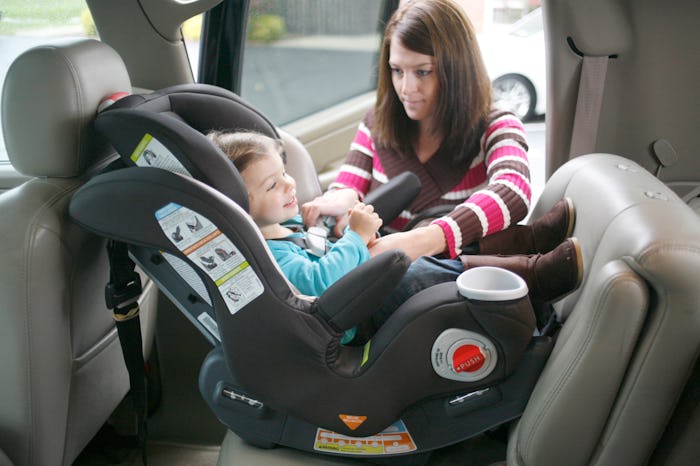Life

The 9 Common Car Seat Mistakes Parents Make
Before you had your baby, you did your best to learn any and everything related to being a mom. And so far it's paying off. You can diaper, nurse, and swaddle a baby with the best of them. But how much do you know about car seats? Of course you know you need one, but are you sure you're using it correctly? Chances are, you may be doing some things wrong. Before you take your baby on another ride, you should know some of the common baby car seat mistakes parents make and, most importantly, how to correct them.
It's easy to think that all you need to do when you bring your car seat home from the store is open the box and put it in the back seat. But if you want to keep your kids safe, you'll need to make sure you're adhering to the guidelines set forth by organizations like the American Academy of Pediatrics and the National Highway Traffic Safety Administration. Improper installation and positioning of the car seat in the car are among the most common areas where parents could use a little improvement.
With a new baby, your plate is pretty full. So take a few minutes to make sure you're using your car seat correctly, and give yourself at least one less thing to worry about.
1You Don't Install It Correctly
Many parents do a great job of picking the right car seat for their child, but very few install their seats correctly. As Parenting pointed out, installing your seat incorrectly can be almost as dangerous as not using one at all. Be sure to read the manual carefully and follow the instructions. And if you're still unsure, have a professional check your work. The National Highway Traffic Safety Administration can help you find someone near you.
2You Let Your Baby Wear Too Many Layers
In the winter months, your kid will probably be bundled from head to toe. But when you get in the car, you should shed some of those layers. According to Baby Center, you should avoid putting anything thicker than a light fleece on your child when placing him in the car seat. Heavy coats and winter gear can loosen the harness leaving him vulnerable in the event of a crash.
3You Don't Fit The Harness Correctly
A car seat is the best way to keep your baby safe and sound when you're on the road. If the harness isn't tight enough, however, she's not as safe as she could be. "I think some parents worry they're going to hurt their child if the harness is too tight," Sarah Tilton, Director of Consumer Advocacy for BRITAX Child Safety, Inc. tells Romper. As Parents mentioned, the harness straps should be tightened until you can't pinch any slack between your thumb and forefinger.
4You're Not Getting The Right Angle
When your baby is in a rear-facing seat, placing the seat at the correct recline angle is important to ensure that their breathing isn't restricted. According to Today's Parent, the best angle for your seat is somewhere around 45 degrees. Many seats will come with an indicator that lets you know if you've got it right. You should also check the manual for suggestions.
5You're Misusing The Tether
Some car seats on the market come with a rear-facing tether which can keep the car seat from moving towards the back seat. If your car seat comes with a tether, it is a good idea to use it. But if you purchase a seat that doesn't come with a tether, do not attempt to tether it, according to The Car Seat Lady. Doing so could cause your child to be injured in a crash.
6You Have The Seat Face Forward Too Soon
You may be anxious to let your baby look at more than the back of a seat, but they are safest riding rear-facing as long as possible. The American Academy of Pediatrics (AAP) recommended children ride in a rear-facing car seat until at least age 2, or until they reach the maximum height and weight for their car seat.
7You Position The Chest Clips Incorrectly
Before you hit the road, it's a good idea to make sure the chest clips of your child's harness have the proper fit. Tilton tells Romper that chest clips should be positioned at armpit level.
8You Don't Utilize The Middle Seat
You may think that placing your child's car seat directly behind yours is the best way to protect him, but that isn't necessarily the case. "If you have one child, the car seat should be placed in the center seating position," Tilton says. Similarly, Mayo Clinic noted that the safest place for your child's car seat is away from active air bags, which could hit your baby's head in the event of a crash.
9You Use A Second-Hand Seat
Let's face it, baby gear is expensive. Although any help you can get from other parents to offset some of your costs is great, it's not always the safest thing for your child. According to Today's Parent, it's best to turn down a previously-loved car seat, unless you know with certainty that it has never been in a crash or is not missing any parts.